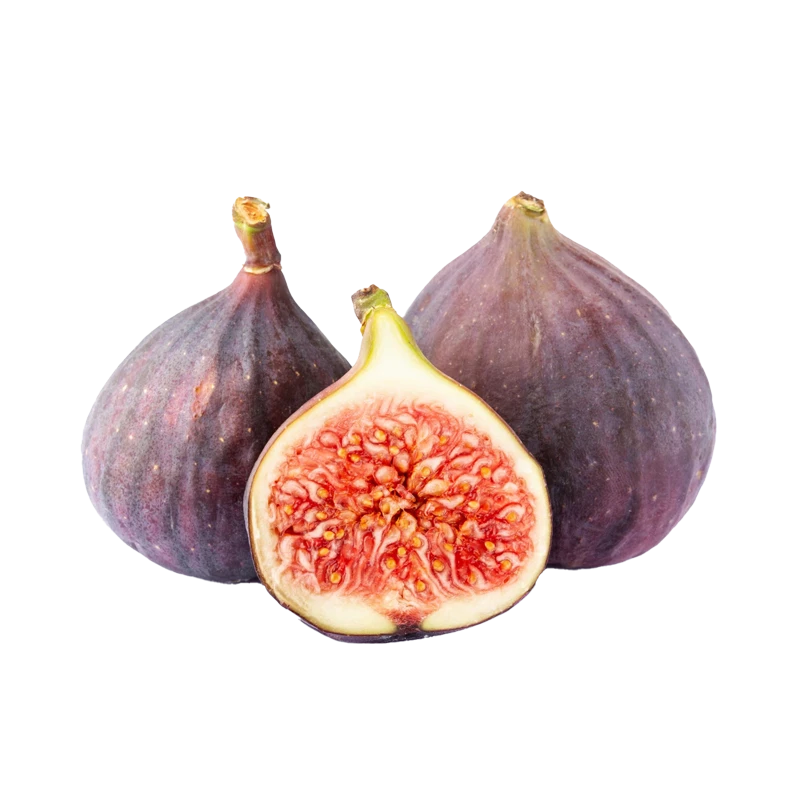Figs — Nutrients, Health Benefits, And Shopping Tips

Written by Listonic Team
Last update on September 6, 2024
Nutrition facts
Nutrition facts
Amount per 100 g
Calories
🔥 74 kcal
| Nutrition per: 100 g | Value | % Daily Value* |
|---|---|---|
| Carbs | 19 g | 6.91% |
| Fiber | 3 g | 10.71% |
| Sugars | 16 g | 32% |
| Glycemic Index | 35 | - |
| Protein | 1 g | 2% |
| Sodium | 1 mg | 0.04% |
| Total Fat | 0 g | - |
*The % of Daily Value (DV) tells you how much a nutrient in a serving of food contributes to a daily diet. 2,000 calories a day is used for general nutrition advice.
Figs are high in fiber and a good source of vitamin B6, especially when dried.
Encyclopedia of Foods. A Guide to Healthy Nutrition
35
🟢 Low Glycemic Index
Did you know?
Health benefits
- High in fiber, promoting digestive health, regular bowel movements, and a healthy gut microbiome.
- Rich in antioxidants, such as polyphenols, which help protect the body from free radicals and reduce inflammation.
- Contains essential vitamins and minerals such as Vitamin A, Vitamin K, potassium, calcium, and magnesium, which support overall health and well-being.
- Supports bone health due to its high calcium content, which is important for maintaining strong bones.
- May help regulate blood sugar levels due to its fiber content, which slows down the absorption of sugar.
- Provides a natural energy boost from natural sugars, making them a nutritious snack option.
Health risks
- High sugar content especially in dried figs, which can contribute to weight gain, tooth decay, and increased risk of diabetes when consumed frequently.
- High calorie content particularly in dried figs, which can lead to weight gain if consumed in large quantities or as part of a calorie-dense diet.
- Potential for digestive discomfort such as bloating or diarrhea due to the high fiber content, especially when consumed in large quantities.
- Allergic reactions in some individuals, particularly those allergic to figs or related fruits, causing symptoms like itching, swelling, or difficulty breathing.
How to choose figs
Figs should be soft to the touch but not mushy, with a rich color and no signs of bruising. Inspect the stem end of each fig; it should be intact and not oozing any sap.
Omit figs that show signs of mold or have a sour smell, as these indicate they are overripe or spoiled. Fresh figs should have a sweet, jammy interior and be aromatic.

How to store figs
Figs should be kept in the refrigerator to retain their freshness. Place them in a shallow bowl covered with plastic wrap or a breathable container. Properly stored, figs can remain fresh for up to a week.
Too much moisture can quickly lead to mold growth on figs. It’s advisable not to wash them until you are ready to eat. Keep figs away from other strong-smelling foods to prevent them from absorbing odors and altering their flavor.
✅ Extra Tip
How long do they last?
Figs can last for 5-7 days in the refrigerator. For longer storage, they can be dried or frozen. Dried figs can last for 6-12 months, and frozen figs can last for up to 12 months.
What to do with leftovers?
Leftover figs can be used in a variety of sweet and savory dishes. Add them to salads with greens, nuts, and a tangy vinaigrette, or serve them with cheese and honey as a simple appetizer. Figs are also great in baked goods, where they add a sweet, jammy texture.
Use figs in a fruit compote to serve with meats like pork or chicken, or mix them into a grain dish like couscous or quinoa for added sweetness. If you have a lot of figs, consider making a batch of fig preserves or jam to enjoy later. Figs can also be sliced and added to pizzas or flatbreads with goat cheese and arugula, or used as a topping for yogurt or oatmeal. For a quick snack, enjoy figs on their own, paired with nuts and cheese, or stuffed with goat cheese and drizzled with honey.
👨⚕️️ Medical disclaimer
Discover products from other categories
Listonic Team
Fact-checked
Our editorial team checked this article to make sure it was accurate at the time of publishing it.
Get the top-rated shopping list app on your phone!







